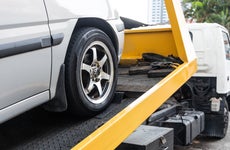Disposition fees: What they are and how to avoid them

The Bankrate promise
At Bankrate we strive to help you make smarter financial decisions. While we adhere to strict , this post may contain references to products from our partners. Here's an explanation for .
At the end of your lease, you choose to buy your car or turn it in. If you choose the latter, you will be charged a lease disposition fee. This charge is assessed by the leasing company and covers the cost of preparing the car for the next buyer. But you may be able to avoid paying it through negotiation or buying the car yourself.
What is a lease disposition fee?
A disposition fee, or a turn-in fee, is a charge to return your leased vehicle. The leasing company charges this fee to cover the cost of cleaning up and repurposing your old car for resale.
The fee is typically around $350, according to Kelley Blue Book. The make and model of the vehicle, the dealership and the city, state or county that it’s located in all influence the disposition fee.
The disposition fee is separate from your monthly payment but may be charged with other types of fees, like early termination charges, excessive mileage charges and excessive wear-and-tear charges.
Do you have to pay the disposition fee?
If a disposition fee is included in your leasing agreement, you can avoid it by purchasing your vehicle or signing another lease — or trying to remove it from the agreement before you sign.
- Purchase your leased vehicle. You can buy your leased vehicle if your contract includes a purchase option. If you buy it, the leasing company may choose not to charge you a disposition fee since it doesn’t have to prepare the car for another buyer.
- Sign another lease. If you sign another lease with the same car dealership or leasing company, it may automatically waive the disposition fee. Otherwise, you can negotiate a fee waiver when structuring the new lease agreement.
- Check the contract before you sign. Sometimes companies don’t charge a disposition fee. If there is one, ask for it to be waived and removed from your lease agreement. Most leasing companies won’t agree — but it’s worth a shot.
Other auto leasing fees to look out for
A disposition fee isn’t the only charge you could expect to face as you’re leasing a car. Look out for other fees.
- Excessive mileage. If you go over the mileage you’re allotted in your lease, you’ll have to pay this penalty.
- Wear-and-tear. If your car has some major dings, scratches or stains, you could face this charge based on the cost of the repairs.
- Early termination fee. If you return your lease before your term expires, you could end up paying extra to get out of your contract.
- Purchase option charge. Some dealerships may have a fee if you decide to buy the car once your lease ends.
- Acquisition fee: The acquisition fee covers the leasing company’s administrative expenses for initiating or originating the lease. This fee can be $300 to $500.
Not all fees are charged or required with a lease agreement. It’s important to review your contract and ask any questions before signing. You may even be able to negotiate some lower or remove them entirely, but you should still count on paying a few additional fees when you lease a car.
The bottom line
Before you lease a vehicle, read your leasing agreement carefully to see if it includes a disposition fee. If you don’t want to pay, ask for it to be waived before signing the contract. Alternatively, you could avoid paying it by purchasing the vehicle at the end of your lease or agreeing to a new lease.
Related Articles



